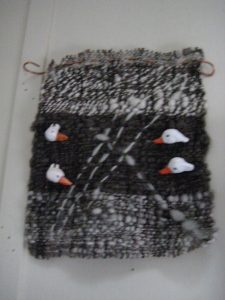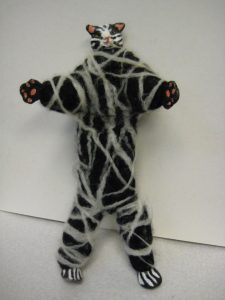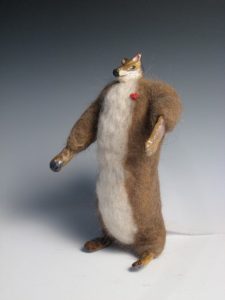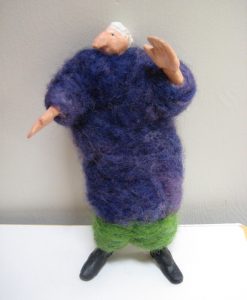I like to create art that elicits an emotion or invites the beholder to imagine a story. That’s why my paintings are often narratives featuring people and/or animals—or locations that exude a sense of mystery.
But I also work in fiber, so how do I infuse my fiber creations with emotion or narrative? I achieve these goals by creating narrative wall hangings and small, needle-felted figures I call “spirit totems”.
When I first began working with fiber, I thought I would be interested in spinning and weaving. However, after several years of trying to learn both skills, I had to acknowledge my shortcomings . First, that I am horribly deficient in the math and three-dimensional visualization skills necessary to warp a loom – and also that the repetitive motions of weaving tend to bore me. Second, I am by nature too nervous and impatient to allow myself to reach the level of spinning expertise where the process is relaxing and meditative. So, if I wanted to continue working in fiber, I needed to find another approach—one that better suits my personality and innate desire to tell stories and create moods.
It all began when I began learning to sculpt. I started working with a friend who sculpts wonderfully imaginative figures from clay and found objects. She generously shared with me her clay, with which I made heads and limbs of people and animals, which she included in her kiln firings. However, I was not comfortable imposing on her time and kiln indefinitely, nor did I want to invest in a kiln myself. Then I discovered polymer clays and was pleased that I could create these same “doll” parts on my own with only a toaster oven rather than a kiln.
Now I felt free to let my imagination loose.
My first efforts were to create narratives with polymer clay heads I made into “buttons” that could be sewed on to 2-dimensional fiber backgrounds.
Among my first creations was a satirical wall hanging inspired by the 22 years I spent working in the corporate world of Silicon Valley. The background for the piece was the only one I ever completed from wool that I had spun myself and woven on a rigid heddle loom during a CNCH workshop I took in Sonoma, CA. It’s called “Corporate Life” and features a corporate hierarchy–layers of management and workers represented by little “button heads” of geese, pigs, goats, sheep –with the “dickhead” figure at the top as the CEO.

Corporate Life
Each character is “wearing” a tie or bow fashioned from pieces of my husband’s old silk ties—or buttons removed from the blouses in my former wardrobe as a marketing executive. The lower portion represents the corporate layoff section of the piece. I embroidered orange and yellow “flames” using the crewel technique I learned from my Norwegian grandmother. Within the flames are charred button heads of pigs –created by accident when I was experimenting with my toaster oven and left them in too long to bake. This work was juried into the 2010 “Innovations in Fiber Art” show at the Sebastopol Center for the Arts.
In another narrative wall hanging I labeled “Working At Cross Purposes”, I sewed geese button heads to a primitive little square I had woven on a child’s simple cardboard loom using the lumpy yarn I had created during my early spinning lessons.

Working at Cross Purposes
By now I had discovered how to create fiber narratives, but had given up traditional weaving and needed to explore other ways to express myself with fiber. I’m not sure how I stumbled upon the idea of creating stand-alone figures, but ever since my childhood I have been interested in dolls, so I decided to head down that path. I bought a book on needle felting and practiced with a few forms, and then I realized I wanted to expand from the simple projects illustrated in the book and figure out how to combine my polymer clay heads, hands and/or feet with my needle felting to create small figures of people or animals.

Cat Jester
In forming the polymer hands/feet and heads I included a hole in each into which I could insert wire to form an armature skeleton of an animal or person. I experimented with different kinds of wire and settled on sturdy but flexible picture hanging wire as my preference. To create a more workable mass for the body, I discovered that pipe cleaners in a color approximating the color of the final fiber layer was a practical solution for ensuring clean edges where fiber meets clay.

Francis Fox (wool and Cat Fur)
Once the armature is complete and wrapped with pipe cleaner, I then continue to form the body shape by covering it in strips of 100% wool batting –cut from the batting sheets sold for quilt stuffing. NOTE: acrylic batting will NOT work since the top layer of roving needs tp adhere to the fibers in the underlying wool during the needle felting process.
I make sure to wrap tightly some extra batting in the areas where the clay pieces are attached to the wire armature –at the neck, for example—thereby giving me adequate surface for needle felting those edges securely.

Grannie Karate Champion
Now begins the final stage of creating a spirit totem—needle felting the outer wool roving or other animal fur/hair that covers the non-clay parts of the figure.
A note on fibers that lend themselves to this final stage of creation. After experimenting with many kinds of animal fur that clients have given me to try (rabbit, cat, dog, alpaca, etc.), I have found only two cats whose undercoat of fur has the texture needed for the process to work. Most fur is too slippery and lacks the microscopic “barbs” needed for fibers to adhere in the needle felting process. With the fur of these two cats, I card the handfuls of fur before using in order to loosen the matted fibers into filmy layers that I can then apply to the underlying wool batting surface. Mostly I use wool roving purchased by the ounce in pre-dyed colors.
Finally, I am ready to employ my barbed felting needles to cover the surface of my final product. Samples of my finished work are shown in the attached photos. You’ll note that some of them feature tiny heart buttons that I have sewn on to further communicate their individual character and “soul”. I invite people to pick them up; they are not fragile. On the contrary, the more they are held the more their bodies continue to “felt” and hold their form. A fellow artist suggested I display them being held in “hands” that I simulate by sewing sand into cotton knit garden gloves. I also use traditional metal doll stands to hold by spirit totems when I display them for sale.
You can learn more about Sandra’s art by visiting www.sandramaresca.com. You can also watch a complete demonstration of me making a spirit totem by visiting the YouTube video featured on my website: https://www.youtube.com/watch?v=M1qGWRqqlhg
Click here for the next article